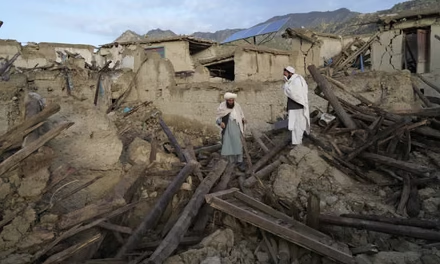Rescue workers are still racing to reach remote Afghan villages days after a powerful earthquake killed more than 1,400 people and left thousands injured. Many survivors are stranded without shelter or medical care, as repeated aftershocks block roads and trigger rockfalls.
The 6.0-magnitude quake struck late Sunday in eastern Afghanistan, near the border with Pakistan. Entire mud-brick homes collapsed while families were sleeping, forcing people to camp outside in fear of their damaged houses crumbling further.
According to Taliban officials, at least 1,469 people have died and more than 3,700 were injured, making it one of the country’s deadliest earthquakes in decades. UN refugee chief Filippo Grandi said the disaster has affected more than half a million people.
Remote Villages Cut Off
The worst destruction hit Kunar province, while nearby Nangarhar and Laghman reported additional casualties. Access to many villages remains extremely difficult. Aid workers say the mountainous terrain and constant aftershocks are slowing rescue efforts.
“Everyone is afraid and there are many aftershocks,” said 35-year-old Awrangzeeb Noori from Dara-i-Nur village in Nangarhar. “We spend all day and night in the field without shelter.”
Save the Children reported that one of its teams had to hike 20 kilometers (12 miles) while carrying medical supplies on their backs to reach survivors.
The World Health Organization has appealed for $4 million to expand emergency health services, warning that hospitals are overwhelmed. “Every hour counts,” said Jamshed Tanoli, WHO’s emergency team lead in Afghanistan.
Aid Efforts Underway
Taliban officials said they have now reached several cut-off areas, but rescue work remains slow. The defense ministry reported 155 helicopter flights in two days to evacuate 2,000 injured people and their families to hospitals. Camps have been set up near the epicenter to coordinate burials, aid distribution, and medical transfers.
Residents in Jalalabad, the closest major city, have begun donating money, blankets, and supplies. “I am a simple laborer and I came here to help the earthquake victims because I felt very sad for them,” said Mohammad Rahman, a local resident.
Aid groups say women and girls are especially at risk during emergencies, given the severe restrictions they face under Taliban rule.
A Country Already in Crisis
The earthquake adds to Afghanistan’s mounting struggles. Around 85% of people live on less than one dollar a day, according to the UN. The country is also dealing with deep poverty, years of war, drought, and the return of Afghans deported from neighboring countries.
The Norwegian Refugee Council warned that sending more Afghans back home will only worsen the crisis.
This is the third major earthquake since the Taliban seized power in 2021. Relief efforts have been hampered by limited resources after international aid was cut, leaving UN operations with less than a third of their needed funding.
Afghanistan is no stranger to devastating earthquakes. In October 2023, a 6.3-magnitude quake in western Herat province killed more than 1,500 people and destroyed over 63,000 homes. Survivors of the latest disaster now face an uncertain future, as help trickles in too slowly for many.






